TabulaRasa – The impact of erasable writing technologies on manuscript cultures

The interdisciplinary project explores the role of rewritability in manuscript cultures and focus on the use of clay and wax tablets in the Ancient Near East, the Classical world, and Medieval to Early Modern Europe.
Jotting down a thought or sketching out an idea—notes are quickly made and just as quickly discarded. Already in antiquity and the Middle Ages, it was common practice to record information on wax tablets, to practise reading and writing, and then to erase the text. From a transcultural perspective, striking parallels emerge between this ephemeral writing and today’s digital media. Such reusable writing supports were widely used, but their fleeting nature means they have so far received little scholarly attention.
At a Glance
| Category | Description |
|---|---|
| Research project | TabulaRasa. Clay, wax, and the impact of erasable writing technologies on manuscript cultures |
| Management | Prof. Dr. Michele Cammarosano (Project leader, Università di Napoli L`Orientale) |
| Faculty | Faculty of Cultural Sciences |
| Institute | CICS - Cologne Institute of Conservation Sciences |
| Persons involved | Prof. Dr. Ester S.B. Ferreira, Dr. Doris Oltrogge, Andreas Krupa M.A. (TH Köln), Prof. Dr. Alessandro Vergara, Prof. Dr. Barbara Liguori, Prof. Dr. Vincenzo Morra (Università di Napoli Federico II) |
| Partners | Prof. Dr. Janet Rethemeyer (Universität zu Köln) |
| Sponsors | European Research Council (ERC) More |
| Duration | 1.5.2025 to 30.4.2030 |
The TabulaRasa project investigates the impact of erasable writing technologies on manuscript cultures. In an interdisciplinary research collaboration with the Università di Napoli L'Orientale and the Università di Napoli Federico II, the Cologne Institute of Conservation Sciences at the TH Köln is pursuing a holistic approach, to which the CICS will contribute experimental archaeological and cultural-historical research, and scientific analyses, focusing on wax tablets.
As part of this project, the TH Köln team will focus on characterizing and reconstructing the material aspects of wax tablets. Originally invented in Mesopotamia, wax tablets were among the most important tools of writen culture in Greco-Roman antiquity, and have been preserved in large numbers, including in the Vesuvian cities of Pompeii and Herculaneum.
The easily transportable wax tablets allow for repeated inscriptions without ink on a surface that is durable in many respects – ideal for outdoor use or travel. This technology has existed for almost four millennia, across various cultures and historical periods, and was still in use in Europe in the 19th century.
The wax tablets essentially consist mostly of a wooden support and the wax coating, which is usually placed in a recess of the support. This raises questions about how the materials for the tablets were selected and processed. In addition to identifying and classifying the wood species used, the tool marks on the wooden tablets are of interest, as they bear witness to historical technology. To determine the exact composition of the rewritable coatings, they will be characterised at the molecular level. The waxes may have been modified with fats, resins, and pigments. The results will be compared with written sources of the period, which can provide information about the type of wood used, ingredients in the wax mixture, and mixing ratios, for example. The test specimens produced at the institute will provide further insights into the production of the wax tablets and help in the optimization of methodology for the planned serial investigation of historical originals.
TabulaRasa is funded by the European Research Council (ERC) through the Consolidator Grant program. The project leader is Michele Cammarosano from the Università di Napoli L'Orientale, Department of Asia, Africa, and the Mediterranean.






